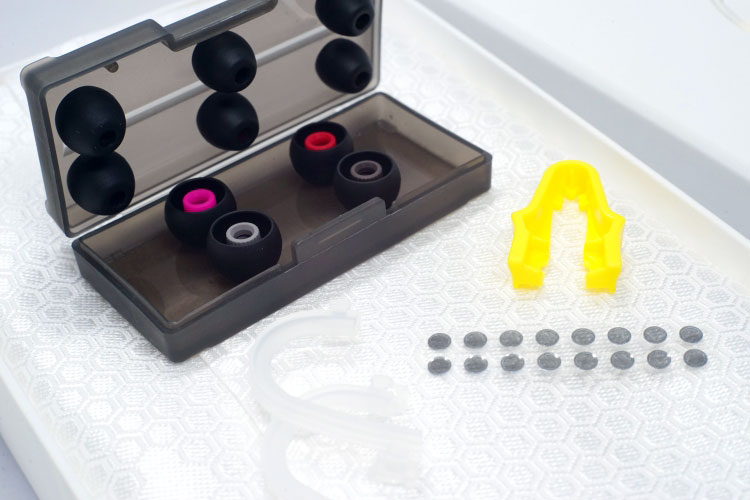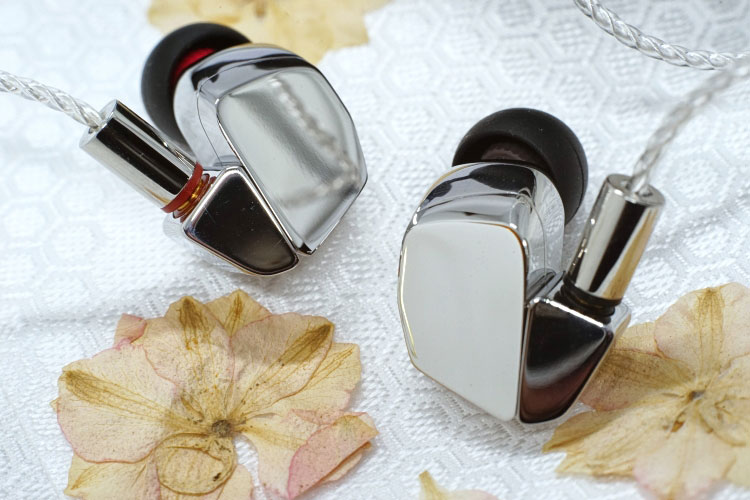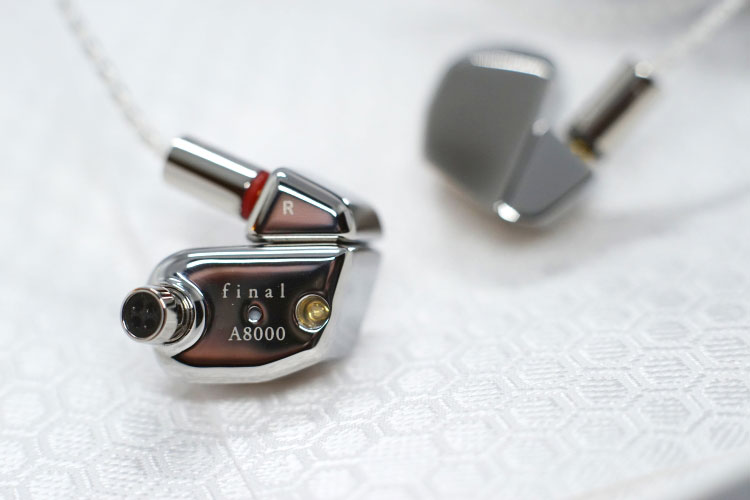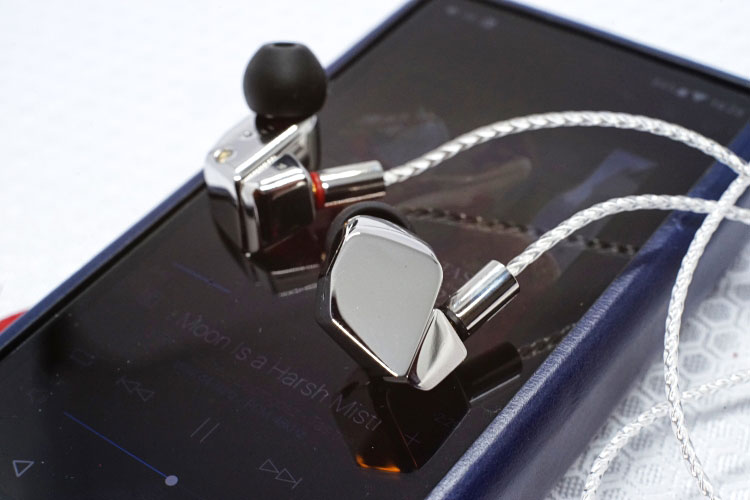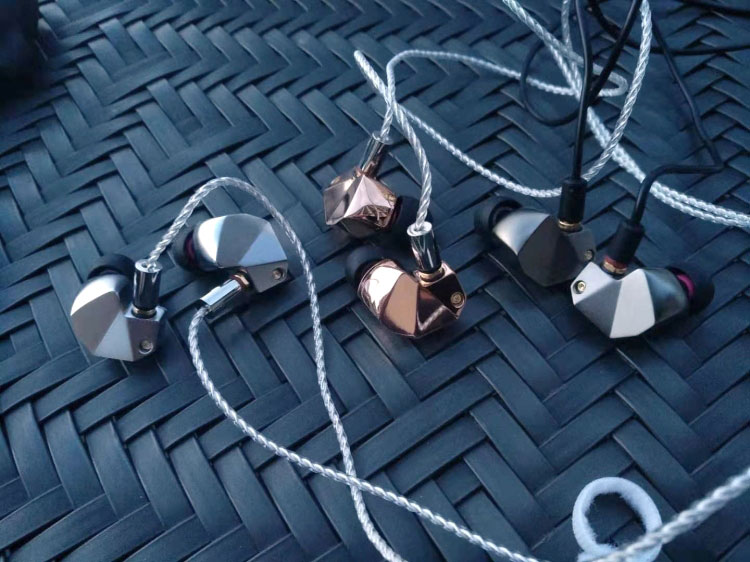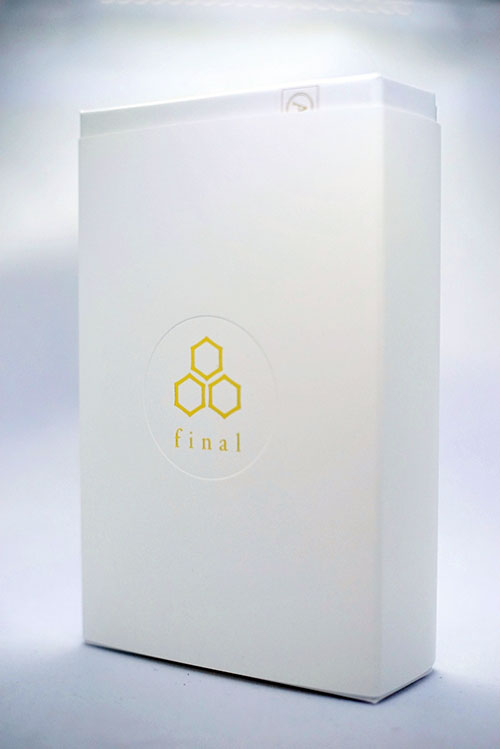The Final A8000 is a flagship dynamic driver universal monitor with an ultra-thin Beryllium foil (Truly Pure Beryllium Diaphragm). It is priced at £1999.
Disclaimer: The Final A8000 sent to us is a sample in exchange for our honest opinion. We thank the team at Final and Hifiheadphones.co.uk for giving us this opportunity.
To read more about Final products we reviewed on Headfonics, click here.
Note, this review follows our new scoring guidelines for 2021 which you can read up on here.
Carrying “A” and the 4 digit number alike the A8000 is the IEM counterpart to their flagship headphone, the D8000.
From the user-defined MAKE series, the psychological research-backed E series, the attempt to tune for specific genres and molding in metal with the B series, to the D8000 headphones where A8000 is derived from, it takes a long way before Final incorporates all the merits of the previous works enabled by the latest pure Beryllium drivers and announces the A8000.
This time we will dive into Final’s new proprietary Perceptual Transparent Measurement (PTM) evaluation methodology and its Tetra-Chamber construction. With the A8000 we are not only reviewing a new IEM but also a new driver consisting of a pure Beryllium membrane and dynamic driver unit design.
The A8000 Pitch
The A8000 has a theme, to reproduce transparent, upbeat sound, quite like what you would expect from something like Stax headphones.
It began when Final experimented with the reconstruction of physical measurement and subjective evaluation methodologies, done on the E series earlier. With the A8000, Final develops a new evaluation index for their subjective evaluation methodology, where the frequency response is predominant amongst factors that determine perceived sound quality.
Final explains that some sound impressions cannot be explained by the existing model, for example, “transparency” in classical music, which suggests clear sound even when the instrument is at a distant position. A8000 aims to sound crystal clear in tone and Final aims at creating an “uplifting experience”.
‘Tuning For All Music’
“The most distinct characteristic of the A8000 is that it realizes such sound quality not by its ability to create sound capable of attracting a small number of wild fans through its strong individuality, but rather sound aimed at greater universality.”
To be an all-rounder for different genres is also another target Final wants to achieve with the A8000. On their website, Final explains the relationship between spatial impression and the dynamic range of music.
For the A8000 a universal-sounding approach to music genre matching is picked, to keep a good balance between pop and classical music. Claiming it is possible to satisfy both worlds with their latest implementations and the ideal pure beryllium membrane, we will see if this is true in the latter part of the review.
PTM
For a long time, Final tuned by modifying the frequency response. However, they realized it doesn’t change the time response enough and it is difficult to achieve transparent sound through such adjustments.
As a response to this challenge, Final developed its own proprietary Perceptual Transparency Measurement (PTM) evaluation methodology. This focused on evaluating and improving interrelations between principal components, with analyses of the results from the subjective evaluation and impulse response data.
After research, Final found an ideal diaphragm material to achieve their tuning in mind, an extremely light, high-speed material called ultra-thin Beryllium foil, (Truly Pure Beryllium Diaphragm), for the A8000 design.
Pure Beryllium Membrane Insight
Beryllium is known for its high density (1.85g/cm³), and 4 times higher hardness than aluminum on the Young Scale which promotes faster sound propagation velocity at 12,900 m/s.
To achieve the transparency, or super responsive, swiftly articulated, and controlled sound, Final engineered ultra-thin, lightweight Beryllium foil (Truly Pure Beryllium Diaphragm) on a new driver unit and acoustical chamber design.
Unlike vacuum deposition coating on another film, the A8000 driver is a pure membrane that allows the driver to respond to signals very quickly and return to the normal position faster than ever, lowering distortion to a very high level.
Tetra-Chamber Construction
Final also shaped the chambers at the front and rear of the driver unit to play a great role in shaping the sound. Final did simulations for the internal design and also repeated sampling until their sound quality targets were reached.
To optimize the operation of the driver, the inside of the chassis is divided into four chambers including the driver ante-chamber, double construction driver post-chambers, and the MMCX connector portion.
The driver is directly mounted into the ante-chamber to suppress unnecessary vibration, to achieve a distinct sound signature and performance.
Packaging and Accessories
A8000 is packed in a similar but upgraded paper packaging box from the B series, with an additional sleeve where Final’s logo is smartly gold stamped on top. Opening up the box you will see a cloth wrap, which feels like the kind of fabric on a kimono, a traditional Japanese garment.
The delicately arranged packaging explains Japan’s packaging philosophy in a subtle but minimalistic and refined manner. The clean. snowy-colored packaging mirrors the “transparent” tuning theme.
Inside the box, you will find the earpieces, a metallic case similar to the E and B series pouch with aluminum covers, some MMCX pin remover, ear hooks, and a case of ear tips with replaceable filters.
There is little to no microphonics with the PVC tubed cables but Final includes some nicely designed ear hooks to eliminate noises. There is a new cable lock mechanism that differentiates from your normal ear hooks making it handy for this face mask era!
Overall, the contents are practical with a consistent design that aligns with the product theme, and the whole experience is a step up from the lower-end series.
Design
The A8000 design has a similar but bigger or heftier form factor than the B1. Both monitor housings are metal injection molded with a delicate mirror finish. The whole body is seamless, very reflective, and finely polished. It feels like sterlingware in the hand bouncing light off the finish at different angles.
Looking more closely you will see the A8000 design has a more rounded cut than the B series build. I would still say the B1 and A8000 are speaking the same design language but the A800 is more fluent and elegant.
Stock Cable
Final developed their in-house MMCX connectors with high-purity OFC silver-coated cables known to provide a wide soundstage.
These jointly-developed cables were originally designed and manufactured by Junkosha in Japan who are well known for developing high transfer speed cables for the supercomputer “Kei” and undersea cables.
The insulator film made from PFA is also developed by Junkosha who specializes in low-permittivity material under the JUNFLON® brand. With heavy stress testing and durable materials expect the cable to be very resistant to sweat and wear and tear.
Final also provide an MMCX ASSIST removal tool to save us from MMCX unplugging nightmares. This is a very effective design for quick removal so that no fingers or cables will be damaged.
Comfort & Isolation
There are a lot of similarities between the B series and A8000, based on similar visual appeal and the A8000 is larger. The A8000 is designed for a superior fit that spreads out the weight more evenly compared to designs that put all the weight at one point of contact.
The A8000 feels slightly big in my ears and due to that larger size, it may not fit very small ears. The insertion depth is not too deep so you can still hear some ambient noise sneaking in.
Sound Impressions
Out of the box, the Final A8000 sounds remarkably clean with an elevated treble, and surprisingly it is not spiky while the treble stands out. Staging is effortlessly wide and deep, the vocal is distanced with a recessed mid-bass tuning yet it is uncurtained and spatially well defined.
The A8000 presentation delivers a lot of micro-detail with great control over sudden volume changes in orchestral works that require excellent dynamic range, with terrific response speed while keeping articulation smooth.
The tuning and speed/texture reminds me of STAX headphones and the ER4 series but the bass isn’t as compromised on the A8000. The cleanliness in the tuning and emotions are well balanced.
As usual, we are letting the earphones run in and impressions will be made by pairing the A8000 with a handful of sources. Final has put some notes on their website for the burn-in process and they stated a long time (150-200 hours) is required before the aging effects on this product level off.
I gave the A8000 15 hours a day for roughly 2 weeks with the cables swapped from my burnt-in E5000. From memory, the bass becomes less shy, and the initial treble sparkle is tamed.
Bass
If you are familiar with Final’s high-end range of offerings you will find the A8000’s bass similar to the D8000, nicely extended, impactful, and clean but not lacking.
The lows are fast and impactful, energetic and dynamic with excellent control and no noticeable roll-off. Its sub-bass can be heard decaying into space yet still retaining an excellent level of resolution.
Bass guitar/ kick drums are nicely separated with multiple instruments in the mix easily tracing and with zero smear. The dynamic range of the low-end is superb with a very tight note reproduction and low distortion at high volume.
The slightly humped but well-controlled bass works well with a slightly recessed mids. It sounds spacious, incredibly detailed, and airy, especially with acoustic instruments.
String picking is clear and the harmonic balance is decidedly euphonic. The bass is perfect for EDM and electronic music with its fast attack and it works well with anything else that needs a fast rhythmic pace.
Mids
The lows transition smoothly and blend naturally into the mids, which are pressed down slightly to boost clarity and resolution along with some humps in the upper mids.
The whole tuning sounds very transparent but could be a compromise for those who want thick, up-front voices. There is ample resolving power for the vocal to be clearly separated from the light-paced bass instruments and the vocal is slightly positioned away but being less veiled than the B1 model.
There is plenty of micro detail present with solid centered positioning. Final has done a great job in spacing out instruments wide rendering both a vocal and instrumental stage that has a hall-like quality.
Treble
The elegant and intense treble is what separates the A8000 from the crowd. The A8000’s agile, textured upper frequencies are incredibly articulate and airy. They are very adept at intricate high-frequency reproduction without sounding clinical and harsh.
This is a bright, well-extended response curve with no sense of rolling off or unexpected sibilant overtones. When it comes to instruments like bells, singing bowls, or tank drums, you can feel the resonances in the air and the details extend right into the upper treble.
Strengthened by the beryllium membrane, the A8000 upper mids and treble sounds exciting but not fatiguing. The driver punches fast, suiting modern pop and rock music very well and offering maximum crispiness to cymbal timbre and other higher-pitched percussion instruments.
It may, however, displease bass-intensive listeners and doesn’t match too well with clean-sounding DAPs or slower-tempo music.
Synergy
The A8000 is rated at 102d SPL with an impedance of 16Ω so the not-too-sensitive A8000 isn’t exactly the easiest for current. However, the A8000 is fairly impervious to hiss on most outputs with lower gain.
The A8000 responds well to power, however, poor output quality may drag down the resolution, making everything less three-dimensional. Underpowered will also deliver more roll-off in the treble with a looser bass.
With more power, the A8000 will sound much more defined with tighter lows, pinpoint accuracy, and impact. For me, warmer and more powerful sources such as the Chord Hugo 2, the Hiby R6 Pro, or the Cayin N6ii have the best synergy with the A8000.
If you are a treblehead and want to push the top-end to the limits for your vocal collection, you will get goosebumps switching up to the higher-gain setting on the QP2R and FiiO’s M11.
Select comparisons
Earsonics STARK
The two IEMs sound completely different in character and coloring. Both designs are outliers for me when compared to most other flagships consisting of multi-BA drivers.
The STARK leans to the bass side and the A8000 to the treble, though they have some traits in common and both require better sources to unleash their true power. The STARK offers overwhelming bass, intimate bass instrument positioning, and a lot of details, especially on the low end.
The A8000 is more laid back in the mid-lows which gives it much more clarity, accompanied by more sparkle in the treble. A 5kHz peak in the A8000 makes lighter voices even more pronounced.
STARK’s multi-driver configuration allows different frequencies to be fine-tuned and extended, with powerful bass and a clear treble. The A8000 comes quite close to delivering energetic bass but shows a much faster response sounding more articulate and coherent. The A8000 is also more forward in the upper frequencies.
What the A8000 lacks is overwhelming on the STARK. You may love to have both in your collection but if you have to pick one, the A8000 has a better transient response and works better with fast-paced music where more bass/treble contrast is required.
The STARK will work better with slower songs and bass instrument-intensive tracks such as rocks or larger ensembles. Also, it pairs nicely with male vocals that require more fullness and power.
Final B1
The A8000 has some similarities with the B1, mainly in how the mids are rendered but with a much faster response speed and a more refreshing treble tuning.
The A8000 is also much more textured than the B1. The bass to mids transition is smoother and less V-shaped in its tuning. Vocals sound more natural and the treble is pronounced on the A8000 compared to the B1. You can feel the driver’s faster response on the A8000 especially when you pair it with phones or other lower power sources.
If you enjoy how the B1 sounds with classical music, the A8000 is a huge staging upgrade similar to moving from a hall to a live venue. At a fraction of the price, the B1 will give you a much better price-to-performance ratio with its similar design and lovely golden-colored housing. The B1 is suitable for casual outdoor listening.
DUNU Luna
Both the Luna and the A8000 are both pure beryllium driver designs but are different in their tuning. The A8000 is more transparent and spacious in sound, a league ahead in picking out brilliant treble detail while maintaining excellent control of the bass.
The LUNA, on the other hand, is colored more to a mainstream sound and has a slower decay that is suitable for a wide range of genres. The Luna delivers more mid-bass content and up-front vocal positioning while sounding reasonably airy and expanded.
The treble on the LUNA is more rounded, and forgiving, and kills off sibilances with a bit of warmth. However, it lacks the elegance and openness of the A8000 and is much less transparent taking away some extension, especially on flatter sounding or smaller outputs.
The exciting treble on the A8000 is one of a kind. While the Luna is more forgiving with different music and gears the A8000 achieves better technicalities, in particular, its pin-point accurate instrument positioning.
However, if you are sensitive to treble or want to listen to music genres that require fuller bass, you may need to equalize the lows for A8000. I recommend pairing it with warmer sources.
Our Verdict
The A8000 has excellent clarity, works well with different genres of music, and sounds very upbeat and uncolored. While boosting treble performance to the max extent it doesn’t compromise musicality. The vocal performance and the low-end are engaging with good weight.
It is an adventurous take to use the flagship open-back planar headphone D8000 as a reference with the A8000’s character steeped in technical excellence.
If you are a treble thrills seeker looking for a transparent-sounding high-end IEM in the market with an extremely low level of distortion, huge staging, and super-fast response, then the A8000 would be an excellent choice.
Final A8000 Specifications
- Product code FI-A8DSSD
- Housing Stainless
- Driver Dynamic driver(Truly Pure Beryllium Diaphragm)
- Connector MMCX
- Cable OFC silver-coated cable
- Sensitivity 102dB
- Impedance 16Ω
- Weight 41g
- Cord length 1.2m



